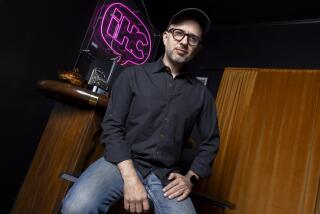Playing the Palace
- Share via
It was once the place to be seen among the Hollywood elite, an opulent and brilliantly designed performance center that hosted such revered entertainers as Al Jolson and Fred Astaire.
Then it became a film house.
And then it went dark.
This weekend, seven decades after its last live stage show, downtown’s historic Palace theater on Broadway will host three days of modern dance performances by local and national artists--some professionals, some beginners--in pieces centered around urban life.
The unusual project, partially funded by the city Cultural Affairs Commission, is the brainchild of former professional dancer and current urban redevelopment attorney Kacy Keys.
She hopes the shows will remind city residents that the 2,200-seat Palace, built in 1911, is more than a gorgeous relic to be preserved. It is, she insists, an ideal place for today’s local artists to show their stuff in performances that could help revive downtown.
“These theaters have so much history and meaning, and could bring this area to life for people today,” Keys said. “We’d like to see this as a first step toward that end.”
In recent years, downtown’s 12 historic theaters--the nation’s largest concentration of such buildings--have been reincarnated as Spanish-language churches, film sets and movie houses. Some remain an empty testament to years gone by.
The Palace, whose stage, lobby and ceiling are ornately decorated with golden and marble flourishes, houses several rare historic sculptures that depict the muses of vaudeville. Its interior is topped by a curving canvas of golden circles, carved balconies and paintings.
Yet for decades it was a seedy movie theater, often frequented by the homeless, before it was purchased by redeveloper Tom Gilmore earlier this year.
The building is now sandwiched between Paul’s Electronics and a Payless shoe store, a far cry from its glory days as the city’s premier vaudeville venue.
“Movie palaces were built for the common man, not the wealthy, and they put on a great show for 50 cents,” said Ted Gooding, Los Angeles regional director of the Theatre Historical Society of America. “You got vaudeville and a movie, sometimes a stage show and pipe organ playing. . . . There’s nothing like this today for regular people.”
Today the Palace is the oldest remaining structure built by the Orpheum vaudeville circuit, Gooding said--a fact that Keys and her dancers confronted in the theater’s ancient electrical system, dusty facilities and nonexistent lighting and climate control.
Each June for the last 15 years, the Los Angeles Conservancy has recognized the downtown theaters’ past glory through its Last Remaining Seats programs, which include vintage film showings, brief vaudeville pieces and discussions.
But not since renowned Russian ballerina Anna Pavlova danced at the Palace in the late 1920s has the theater seen professional dance--or virtually any live performance--on its massive stage, framed with ornate carvings and red velvet curtains, according to Steve Markham, an expert on historic theaters.
*
It had been so long that, when Keys’ Praxis Project began rehearsing a month ago, Markham found it odd that people were actually leaping and spinning on stage.
“It was strange to see real people dancing up there,” said Markham, chuckling. He is a onetime vaudeville performer and current artistic director of the Friends of the Orpheum, a historic theater preservation group.
“The preservation community is very enthusiastic about the history of these places, but what I find equally important is [their] future,” Keys said. “They need use. If they’re not being used, they die.”
Late last year, she obtained $6,500 in funding and began recruiting instructors, many connected to Ronald Brown, a former member of the Alvin Ailey troupe and UCLA Dance Company who returned to Los Angeles from abroad to help choreograph Praxis.
Gilmore, who worked with Keys in her role as an attorney and former city employee to redevelop other historic properties downtown, donated the space, minus operating costs.
The troupe consists of some veterans and anyone else who responded to fliers and ads. For some beginners, the performances will be their first ever before an audience.
Gilmore’s support, plus grant funds and several thousand dollars from Keys’ savings account, have helped create a project that pays homage to city life.
The eight dance pieces have such titles as “Subway,” “Faceless,” “Wayfaring” and “Praxis,” which means the practice--as opposed to theory--of an art or science.
“The ‘Praxis’ piece reminds me of sitting in Pershing Square for a day and observing who passes by at different times,” Keys said.
With luck, and decent attendance at this weekend’s performances, organizers hope to make Praxis a permanent troupe.
“We weren’t really looking past this first show until recently,” said Keys’ husband, Craig, the show’s producer and a musician who also works for the Community Redevelopment Agency. “But with the classes and growing interest, we’re thinking of doing more. . . . There are just not that many places where you can give a performance in front of this size of theater. It’s an inspiration.”
Praxis performs tonight at 8 and Sunday at 2 p.m. at 603 S. Broadway. Tickets, sold at the theater only, are $10-15.
More to Read
The biggest entertainment stories
Get our big stories about Hollywood, film, television, music, arts, culture and more right in your inbox as soon as they publish.
You may occasionally receive promotional content from the Los Angeles Times.










